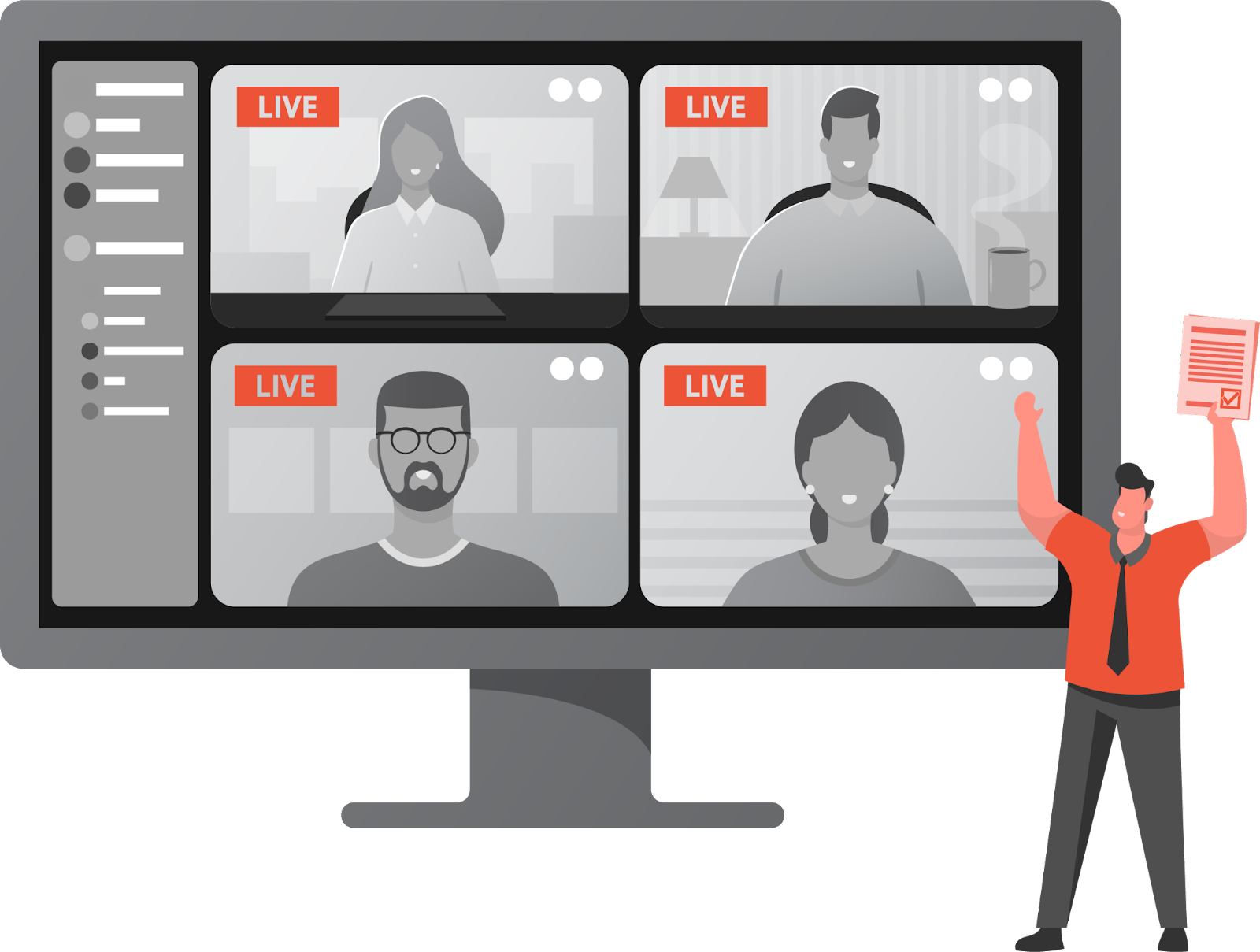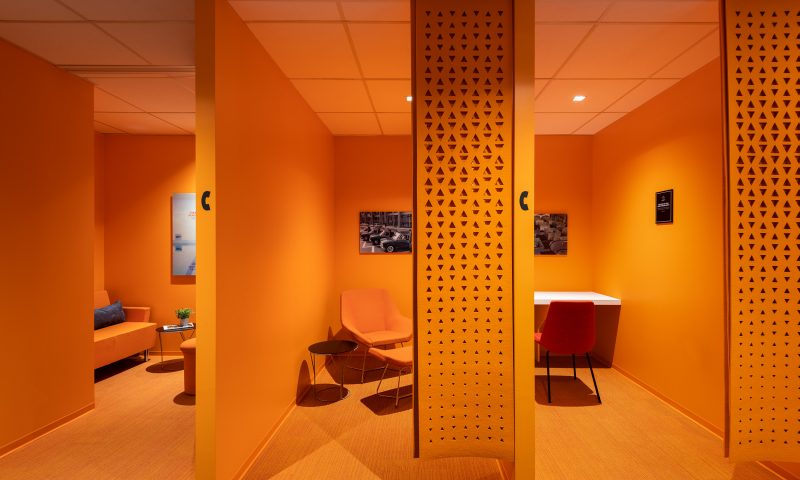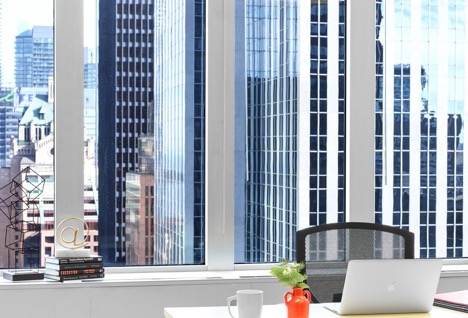Coworking Community Building: A Blueprint for Professional Collaboration and Networking in 2024
Unveiling Innovative Strategies for Nurturing Dynamic Workplace Communities

There is a reason that coworking spaces continue to focus more and more on the community element. Community is in many ways, vital to the success of a workplace space. There are many ways in which this has been shown, where individuals contributing to a work task not only thrive within the company as a whole but also within their own goals. Here are some of the most obvious benefits:
- Networking Opportunities: Coworking spaces bring different professionals together, all of whom are a small portion of diverse backgrounds, skill sets, and industries. These spaces allow people to meet others with different interests and skills, thus expanding the potential for professional relationships. They can also connect with others who can provide assistance and advice. Learning from each other is a key benefit to operating within a community-driven space.
- Support Systems: Everyone needs a support system to encourage them through tough times, and that includes within the professional realm. Support systems within coworking spaces can create a sense of belonging, especially with like-minded people who are pursuing similar goals.
- Community Events: Often hosting community events that enhance networking opportunities. These events help freelance and independent professionals connect, learn, and grow from others who are similar or even dissimilar from themselves. Social events create a sense of belonging and are good for those who are used to working alone, curating a fun, enjoyable environment.
- Collaboration: There is a plethora of opportunities for collaboration, whether it be formally, or informally collaboration leads to new ideas and even newer possible business opportunities. Various fields can combine their differing skills and create fresh ideas that may not have existed outside the coworking community zone.
- Flexibility: Coworking spaces, compared to traditional office spaces, allow much more flexibility concerning when, how, and where individuals work. Flexibility is beneficial for those working a non-traditional job or schedule. This makes for an appealing option for growing businesses or small teams.
Based on historical data from 2018 through 2022, the total number of coworking spaces is set to reach nearly 42,000 worldwide by the end of 2024. The coworking industry is flourishing, but the ones that stick around place a sense of community at the top of their list.
Innovative Strategies: Workshops, Networking Events, and Collaborative Projects
There are many ways that a member company can begin growing its individualized sense of community within a flexible shared workspace. But you might not know exactly where to start, outside finding a space that is intuitively collaborative, so here are some tips:
- Introduce New Members: Send out welcoming packets, plan introductory coffee sessions, create a buddy system with a seasoned member for a week, or create a community wall where new members’ photos and a short bio are displayed. Remember, some people take a bit to open up, while some are outgoing from the get-go. Be patient, and offer a multitude of welcoming gestures that make each individual feel uniquely appreciated and comfortable.
- Organize Events: Planning events like workshops, yoga sessions, and Friday night music jams is an additional step in drawing members together. Flexible Workspaces often offer to manage several of these events for member companies and you can also host your own events within the space dedicated to your team privately. Best of all the space can usually help you manage your own private events so ask!
- Share Brand Stories: Every brand has a unique origin story—share yours with both your new staff and your extended workspace member community, inviting them into your world. Tactical examples include hosting brand-themed storytelling events becoming the community host, or initiating the building of an interactive visual narrative for all members on a dedicated wall in the space.
- Connect People: Match together people who you think can create magic together tapping into the broader talent pool from other member companies. Use coffee breaks, lunches, or even during a networking event to introduce an individual who you think could benefit from the introduction. Of course, this is also a benefit you can personally enjoy. Use access to the member directly to full advantage in order to discover natural alliances, sales opportunities, partnerships or friendships.
- Balance Needs and Expectations: People are inherently different. Companies are figuring out that key differences between workers mean that the management style and approach toward maintaining a healthy work environment is going to differ from person to person. That is what makes coworking spaces so valuable; their flexibility with environment, amenities, recreation, lighting, climate control, and ergonomic comfort. For your own company also stay flexible and avoid applying a one-size-fits-all approach to leverage the space to your company’s advantage.
Future Trends: Predictions for Coworking Communities
The future of coworking looks exceedingly bright. Here are a few predictions for 2024 and beyond, according to workplace solutions:
- Go Green, Stay Green: Sustainability isn’t just a trend anymore; it is the way of the future, as is the addition of wellness initiatives. Mediation rooms, fitness corners, and access to nearby parks will become the norm, along with composting facilities, solar panels, and rainwater harvesting.
- Hospitality Hubs: Providing up-to-date amenities has already proven to enhance worker satisfaction, and premium coworking spaces are going to continue to innovate, leading the industry. Gourmet coffee and tea, artisanal snacks, onsite gyms with fitness classes, childcare, and even pet-friendly zones are becoming more common.
- AI Presence, but not Takeover: Technology will continue to advance, with automated booking systems and AI-powered meeting assistants that take notes while humans brainstorm. That being said a human, genuine connection continues to be wanted and needed.
- No More Niche: A one-size-fits-all approach is gone. Coworking spaces are more than willing to tailor to specific industries, like fashion designers who need on-site garment racks, or music producers who need soundproof recording studios.
- Creativity Soars: Vibrant coworking spaces are now being curated to aid in enhancing creativity. This means capturing client’s attention and imagination – think in-house chefs, pop-up art galleries, and rooftop yoga!
- Flexibility First: As we have seen, flexibility is the way of the future when it comes to shared workspace. The pandemic was the catylist and we work is forever changed. Flexible design for a modern hybrid workforce will only continue to thrive.
- Tech Up: Spaces continue to invest in cutting-edge, like temperature sensors that adjust automatically, noise-canceling booths for those who need more focus, and even AR/VR waiting rooms to entertain members and their guests. Holograms are no longer science-fiction and have become science-fact.
The Professional Centre’s Approach: Tailoring Community-Building to Professionals
Unlike a traditional office space, which was often closed off with limited interaction between workers, The Professional Centre is designed with a mix of sophisticated private and open layouts for maximum customization and access to a suite of amenities. Sophisticated suites with natural sunlight and varying options in workspaces. A summary of the spaces we offer, as well as the amenities that contribute to the sense of community, are as follows:
- Private Offices: While prioritizing privacy, access to private offices for solo work also includes tastefully sleek and designed meeting rooms and collaboration zones.
- Meeting Rooms: Inspiring meeting rooms that range in various sizes, all with a dynamic setup designed with collaboration and relationship building in mind. Sleek and modernly ergonomic furniture creates a soft and welcoming ambiance that accommodates working styles.
- Enterprise Offices: Entire offices can be booked and tailored to specific company needs, all with community and collaboration in mind. Pick from three separate options that blend private offices with transparent dividers, coworking spaces, executer window offices, and optimally open meeting rooms.
- On-Demand Offices: On-demand offices at TPC offer the flexibility previously mentioned that enhances the notion of community and collaboration. Pay-as-you-need offices release the stress of permanent office maintenance, whether it is required for a day, a week, or even a month.
- Community Amenities & Concierge Support: From a fully stocked up and snacked-out kitchen, to quiet meditation or prayer spaces, to spacious lounges, to an experienced technical and administrative team, TPC acts as a muse for businesses looking to enhance their sense of community.
Here are a few success stories and testimonials from companies who have found The Professional Centre’s community coworking space to be conducive to their company mandate:
“It’s a complete turnkey solution. The Professional Centre provides everything that we need to run our office and also gives us access to the kind of equipment that we could never afford to have on our own.”
Stephen Griggs, Executive Director – Canadian Coalition for Good Governance
“Whether it is the phone answering service that creates the presence of Iomega as a credible entity to its customers; the professional administrative support that is provided on an ongoing basis, or the tastefully designed and well-provisioned boardrooms, which have been instrumental in cementing contracts and relationships — all contribute to a truly professional atmosphere and pleasurable working environment.” Wally Schmidt, Manager – Canada Iomega
“Nikki and the team at The Professional Centre have been incredible in helping us get our Toronto team started. The tenure of her support team and their expertise has helped us win both clients and hire the best senior individuals. The fact that The Professional Centre also has a very long tenure of tenants/clients shows that the level and quality of service has remained high for many years.”
Sheldon North, Corporate Affairs – BGC Engineering Inc.
Located in the heart of Toronto’s downtown financial district, The Professional Centre (TPC), is committed to aligning with evolving work dynamics with high performance professionals. Take advantage of our location to lower your operational costs while enjoying the vibrancy of a community that thrives on innovation and collaboration.
Explore TPC’s flexibly designed and fully managed workspace solutions here.
How to Best Design a Hybrid Work Environment
You must have heard of them by now, these fancy new work environments. In the wake of a global pandemic, people had to come up with all-new ways of gathering and working, and a few of these methods seem to have struck a positive chord. With all this talk of “Work from Home” here, and “Work from Anywhere” there, and how they’re the future of the workplace in a post-covid world.
“It’ll boost productivity!”, they say. “Employees love it! It helps create the best work-life balance!” These statements ring true, generally – though there’s a bit of nuance at play. These successes are not universal, and there are some things that classic work structures are just superior for.

Online workplaces just can’t replicate the feeling of being around people. It’s hard to develop office friendships, meet new people, and forge career-building connections (Bloom, 2021b). And that’s just one example.
So, is there a way to get the best of both worlds? Can we pick up all the productivity benefits of WFH without abandoning the benefits of office work? Turns out: the answer may actually be “yes”. A “Hybrid model” aims to do just that. And with the help of research data, we aim to demonstrate exactly how that works, while giving practical advice on how that data can improve your business.
This article is all about understanding. We’re not just going to give you a few bullet points and call it a day, falsely satisfied in the knowledge that our readers can most definitely, 100% apply this knowledge in the best possible way. We know that’s not true – and any article claiming otherwise will inevitably lack the depth you need to truly see the benefits of a hybrid workplace model. In this industry, there is no one-size-fits all solution. Every business is different, and knowing the hows and whys are the ingredients to creating the best system that fits your business. Take our advice to heart, but don’t feel as though you need to follow each step to the letter. Nobody knows your business like you do, and that means you’re in the best position to know what is and isn’t beneficial. Pick the options that work best for you.
Developing an Understanding
So, first things first. What exactly is a “Hybrid model”? We know the things being hybridized – working from home, and working from an office. This isn’t a question of definitions, but of degrees. What is the balance that a hybrid workforce aims for?
The exact numbers tend to vary. Some companies prefer to lean on the WFH direction, only calling employees together for larger meetings, discussions, and so on. Others operate mostly from an office, sometimes encouraging people to work from home on 2 out of the 5 weekdays. Other companies leave that choice up to the worker themselves.
There is a significant amount of variance between how often people actually want to work from home. Some groups prefer to spend as much time as possible at home. The next biggest group of people only want to work at home “rarely or never” (Bloom, 2021a).
Each of these options will vary – both in their effectiveness, and in how much management work it creates for anyone trying to organize staff. We will dive more into that distinction later.
Hybrid work also varies in popularity from generation to generation. The older crowd, as you may expect, prefers to work in the way they’ve always known, and are more resistant to change. Meanwhile, for a group like generation Z, the results are intriguing: 74% have a preference either for working from home, or in a hybrid model (Afshar, 2020).
But one universally-loved popularity metric is the stat on productivity. It doesn’t apply in literally every case, as employees living with children may face more distractions than others (Toscano et al, 2021), but speaking in very general terms, most workplaces will see a boost. In workplaces that introduce WFH policies, 83% saw productivity increase to some extent (Hunter, 2018).

One study from Stanford University had something really special to say about WFH productivity: that it was equivalent to an entire extra day of work completed each week (Bloom et al, 2013). Do note that this comparison is based on employees working fully from home, as opposed to working fully from an office. The hybrid model will see this boost in a partial sense, but not fully.
Most articles will immediately follow this productivity data up with how popular WFH is among the workforce itself. We already know the generational-based counterexample to that, but in most cases workers do, in fact, prefer a WFH option. 55% of them, in fact.
(Bloom, 2020).
Another study found that WFH was so valued, that it was worth 6% of an employee’s wage – they’d pay that to get a chance to work where they pleased (Bloom, 2021b). That willingness applies to 42% of the workforce, by the way (Corps, 2018).
With numbers like this, it’s no wonder why businesses are quickly catching on to the trend. 82% of businesses already have, or plan to, introduce some elements of WFH into their structure (Baker, 2020).
So as businesses make the shift, what is it that they’ll discover? WFH has differing strengths and weaknesses after all, and we just covered the strengths. So, what’s the catch?
As mentioned earlier, employees may struggle to find connections with other workers. Collaboration will be harder. Networking will prove challenging. WFH is really good for structures where everyone breaks off to work on their own thing, and discourages all other forms of work.

It’s possible that meeting productivity may also take a hit. For smaller meetings – say, between 4 workers – the downsides will be negligible. But for larger meetings, where everyone may struggle to fit on the same screen, issues can start to crop up (Bloom, 2021a). Even if everyone is easily audible, there are some messages that can get lost without a visual aid. People communicate using gestures and facial expressions fairly often, without even realizing they’re doing it. Likewise, many people can pick up these subtle details with relative ease, provided they have the information needed to do so. The lack of visual presence in a large digital meeting robs them of that information. As such, communication becomes more difficult.
A common worry that many business owners have is in regards to household distractions. To their credit, there are definitely times where workers can be hindered by the presence of so many attention-grabbing things. We already have data from crowded workplaces vs sparse ones (Terence, 2001), and the results prove our intuition. The difference is, though, that this doesn’t apply to WFH – at least, not always. Since workers are incentivized to maintain some level of productivity (the desire to keep one’s job is a powerful force), they have reason to minimize their own distractions. And since they work from home instead of an office, they now have the authority to do so. At least, they usually do.
Some factors are simply out of a worker’s control, though. Children are an easy example, but countless others exist. And for workers who may face them frequently, productivity may decrease. So while, in general, you can expect a productivity boost from WFH, it’s worth checking in with your workforce before instituting WFH policies, if possible. The productivity boost is not universal, but it is largely predictable.
The Best Model for You
Judging by all known sources, a hybrid model offers enough flexibility to maximize the strength of both WFH and traditional office models, while minimizing the weaknesses. But it’s a kind of flexibility that must be used mindfully, it’s not inherent to the process.
WFH has two main strengths: the agency offered to the workers, and the productivity increase for the employers. But it’s weaker in terms of collaboration and interaction between workers. Is it possible to maintain the agency that creates productivity, while maintaining the interpersonal aspects of a traditional office?
And so, we bring things back to our initial question. It’s clear that including some measure of WFH into your workplace model will be worthwhile. But it does come with some downsides. How much of those downsides are you, and your workforce, willing to endure?
The short answer is: it depends. That is why we spent so much time exploring the how and why of WFH – every factor depends on the needs of your business. How often do you need to assign collaborative tasks? How often do you hold large-capacity meetings? What does the typical home life look like for your average worker? If your answers are “often, often, and adults with young children to look after”, you may prefer to lean in a traditional direction. Other answers will, obviously, create a whole different kind of optimal model.
One significant choice that must be made in this model is in allowing workers to choose their own days worked from home. Will employees prefer to work Monday and Friday at home? Or perhaps Wednesday and Thursday?
Unlike the choice between WFH and traditional offices, you will likely need to take a firmer stance here. There are few generally-applicable sources in this area, which means you’ll need to choose the model that best fits your workplace.
For example: if you plan on coordinating an in-person meeting, or have multiple employees collaborate on a task simultaneously, then all those involved will need to ensure they chose the same day to arrive at work in-person. Since these same workers will likely be planning their own lives based on when they can or can’t be at home, they will need some predictive way to determine their must-be-at-work days. That means coordinating things far ahead of time, which means you need a system for archiving and distributing those predictions, and so on. If your business focuses very heavily on non-collaborative tasks, then such an endeavor may be worthwhile – but that will not be every business.
Another choice could lie in an inversion of that process. What if your business is on the other end of the spectrum, and benefits from a primarily WFH model? The disadvantages of WFH will need a counterbalance, but is it worth setting up an entire office complex just for that? The answer is likely a definitive “no”.
But that doesn’t mean the question is unsolvable. It just needs a shift in perspective. How can you get a powerful office space, if you won’t need or use it 24/7? The answer is, of course, a rental. There are plenty of services out there willing to host any number of employees – be it small teams or whole networks of people.
Book a meeting room in Toronto
If your business works best with a separated work/home space, but doesn’t need it to be a permanent fixture, The Professional Centre has plenty of options to fill your exact niche.

Pick up all the benefits of a centralized workplace, without any of the firm anchors keeping your business model rooted in a single method. Whether you need to service a large team or a small meeting, The Professional Centre can supply the exact kind of space you need to enhance your team’s productivity.
Works Cited:
Afshar, V. (2020, July 7). The future of work is hybrid: Work from home and the Workplace. ZDNET. Retrieved October 11, 2022, from https://www.zdnet.com/article/future-of-work-hybrid-home-and-workplace/
Baker, M. (2020, July 14). Gartner Survey reveals 82% of company leaders plan to allow employees to work remotely some of the time. Gartner. Retrieved October 11, 2022, from https://www.gartner.com/en/newsroom/press-releases/2020-07-14-gartner-survey-reveals-82-percent-of-company-leaders-plan-to-allow-employees-to-work-remotely-some-of-the-time
Bloom, N. (2020). How working from Home Works Out. Stanford Institute for Economic Policy Research (SIEPR). Retrieved October 11, 2022, from https://siepr.stanford.edu/publications/policy-brief/how-working-home-works-out
Bloom, N. (2021, June). Hybrid is the future of work. Stanford Institute for Economic Policy Research (SIEPR). Retrieved October 11, 2022, from https://siepr.stanford.edu/publications/policy-brief/hybrid-future-work
Bloom, N. (2021, March 21). Our research shows working from home works, in moderation | nick bloom. The Guardian. Retrieved October 11, 2022, from https://www.theguardian.com/commentisfree/2021/mar/21/research-working-from-home
Bloom, N., Liang, J., Roberts, J., & Ying, Z. J. (2013). Does working from home work? evidence from a Chinese experiment. https://doi.org/10.3386/w18871
Corps, M. (2018, June 30). Survey of working adults shows U.S. employees willing to take pay cut for workplace flexibility. Survey of Working Adults Shows U.S. Employees Willing to Take Pay Cut for Workplace Flexibility. Retrieved October 11, 2022, from https://www.prnewswire.com/news-releases/survey-of-working-adults-shows-us-employees-willing-to-take-pay-cut-for-workplace-flexibility-128877868.html
Hunter, P. (2018). Remote working in research. EMBO Reports, 20(1). https://doi.org/10.15252/embr.201847435
Terence M. Murphy (2001) The Effects of a Crowded Workplace on Morale and Productivity, Journal of Histotechnology, 24:1, 9-15, DOI: 10.1179/his.2001.24.1.9
Toscano, F., & Zappalà, S. (2021). Overall job performance, remote work engagement, living with children, and remote work productivity during the COVID-19 pandemic. European Journal of Psychology Open, 80(3), 133–142. https://doi.org/10.1024/2673-8627/a000015
Transitioning to a Hybrid Workforce:

In the year 2020 there is only one thing that we can be certain of, and it is that we cannot be certain of much right now. With the state of the pandemic constantly evolving, our lives have changed many times over the last 7 months, and we have and will continue to adapt. The main lesson we are all learning is that flexibility is an essential mindset right now, especially when it comes to work; “flexible” is becoming the word of the future.
Though it was previously only considered a luxury that many of us wished for, working from home became the new normal when COVID-19 first hit. Due to how little information we had on the virus at the time, companies had no choice but to shut their office doors and make their teams entirely remote. And yet, work-from-home has received mixed reviews from the general public, with some people loving their newfound freedom and others feeling major negative effects on their productivity. This has led many to believe that there is no “one-size-fits-all” solution, and many companies are coming to the realization that a hybrid work model is the best option moving forward.
If you are new to the terms “hybrid work model” or “hybrid team”, they describe situations where part of a team works from home and part of it works together in one space. “Mobile workforce” and “mobile employees” are phrases that have actually been around for a while, with many fields of work having employees who choose whether they come into the office or use a separate space.
What is new, though, is that now much of the workforce is mobile, and chances are that even if offices open their doors again, some people will still opt to continue working from home for at least part of the week. People enjoy the freedom that comes with working from home. They get to choose their own schedules, adjust their hours to their needs, and spend more time with their households. Some have never even enjoyed going into the office in the first place.
There is also another category of workers that will choose neither work from home or the office. Some are dubbing it the “work-from-here” crowd. These employees may have found their own alternative options to working from home, such as renting desks at flexible workspace providers or working in public areas for the day. They may be content with their individual solutions and may not want to switch up their routines too much with returning to the office.
This does not mean, however, that we should not open our doors again. On the other hand, plenty of newly remote employees are reporting feeling less productive, less connected to their cause, and less responsible for their work. Some do not have a designated workspace in their homes, are taking on learning-from-home with children, or simply have too many people in their home space to work effectively. It has also been difficult for smaller companies to maintain their company culture with so many distributed team members. The place for communal discussion is getting lost in translation over virtual screens and chats, and employees are losing out on the small interactions that make them feel connected to their peers. There are also many additional financial commitments related to cybersecurity, software, tech support, and more that come with an entirely remote team.
So, it is now looking like a hybrid model of work is the best option for everyone, as it incorporates options for most types of employees. In order to incorporate a hybrid model of work, your company will need a flexible return to work plan – there’s that word again – that allows employees to work from home (or here) at times while also giving them a private and collaborative office space in which they can be productive. It is also important, when implementing a flexible work policy, that this policy is adaptable to the evolving pandemic status.
Rent affordable office space. If you or your company is looking for an affordable way to bring employees back into the office, flexible workspaces are your solution. You can find many different sizes of office space and services to accommodate your company’s needs. As an example, The Professional Centre offers different sized offices that accommodate teams from up to 100 people and down to singular desks for individuals. The amenities and high touch areas are being sanitized frequently throughout the day, masks are required in all common areas, and there are air purifiers placed regularly throughout the floors to ensure it is as safe as possible. You can set your team up with support services, meeting rooms, mail, and more, at affordable prices.
Get your team on a rotating schedule. If part of your team is working from home, one option is to rent out a smaller office (e.g. one sized for 4 people) and have teams of 8-10 people come in on rotating schedules. Your team can then work from home part of the week and still be able to work together for the rest of it. Team members will be able to choose their own schedules, still enjoy the freedom of remote work for part of the week, and also start working together in a centralized space again. It also allows you to explore more affordable workspace options, as you will not need to make space for everyone on the same day. Even large companies, such as Google, are embracing the rotating schedule and have opened their doors at a lower capacity to ensure there is a safe amount of people using the office at one time.
In order to ensure the hybrid work culture succeeds for your team, there are a few things you should take note of.
There should be open communication with you and your team members. Some may be reluctant to return to the office due to conflicting schedules, childcare, or safety concerns. Being flexible to their needs and open to hearing critiques will build a strong foundation of trust between you and your team. There should also be clear indications as to why they are being asked to return to the office. Explaining why and how it will be done is vital to ensuring your team feels it is safe to return.
Offer support to both types of employees. Remote team members may be struggling in different ways compared to your co-located team, so ensure you are checking in regularly and being flexible for both types of employees. Some may feel they are being asked to take risk by coming into the office but may also feel they are not fully benefiting from remote work. It is important to allow your team to voice any concerns and issues they may have. It is also important to look out for signs of burnout, as it has become a growing problem with work during the pandemic.
Be inclusive to both types of team members. There should be no sense of favoritism between your co-located and remote teams, as you do not want an “us vs. them” situation to occur. Remote team members may start to feel that there is more focus being given to the in-office staff, if you are not cognizant of it. To avoid this, ensure that both types of team members are receiving information in the same way. All of your meetings should continue to take place on a video conferencing platform, continue sending out important information through group emails or chat channels, and set the same objectives for all team members, regardless of where they are working. If new topics of discussion come up in-office, always suggest getting remote team members on a call to discuss, to ensure no one feels they are being left out of the loop. It is also important that if you still have staff that do not want to return to the office, that you are ensuring that they still get face-to-face time with you virtually.
Help your team through their re-entry anxiety. Some of your employees may be struggling with being asked to return. Some may feel that you are asking them to put themselves at risk, so ensure that your space is as safe as possible and that you are taking all precautions necessary when it comes to managing COVID-19. It is also important to continue to be flexible on how often you ask them to return, as one important factor in navigating re-entry anxiety, is to not do too much at once. You can see an in-depth list of ways to navigate returning to the office here.
Our current reality is built around flexibility. Flexible working, where employees are able to center their work schedules around their current commitments, is most likely here to stay. The next step is to offer your team a safe and secure space to work in, and with everyone dealing with financial stress, flexible workspaces are the way forward. Renting more affordable smaller spaces is a great financial alternative to traditional office space. Finally, having a flexible in-office policy will allow you to rent the smaller space and let your larger team choose when they come in and what days they would like to coordinate with the rest of the team. This is going to be the new way forward and we are looking forward to helping companies with this transition.
Rethinking your organization’s workspace? Discover our flexibly designed and fully managed enterprise office solutions.
How to Navigate Returning to the Office

When COVID-19 first hit and cities issued stay-at-home orders, everyone’s major concern was whether or not they could adjust to a life of isolation. “It will be over soon, right?” was the universal phrase being uttered worldwide across virtual meetings and calls, over the course of March and April.
Now however, months into this new normal, we have all adapted (to varying degrees) to a world in which the pandemic is not yet over, but in which we are all learning to exist alongside it. As we enter Fall, cities have been lifting restrictions, businesses are being allowed to reopen, and companies are looking to call their employees back to the office. Many individuals and entrepreneurs are also looking into finding designated workspaces again.
Though we cannot predict the future, it is likely that cities will remain open to a certain extent despite the pandemic and with these changes in the air and the number of cases fluctuating, many have renewed concerns about what returning to work and the public world is going to look like. It is a stress called “re-entry anxiety” – a combination of fear of exposure to the outside world and health-related anxiety about COVID-19.
For many, this fear arises in the context of having to return to the office. There is so much more uncertainty that exists in our new world and people are going to have to learn how to navigate it, especially as the working world begins to open its doors again. Managing public transport, using public facilities, and how to share space with colleagues again can be nerve wracking to say the least.
Many companies are looking to call their employees back to the office, even within the uncertainty of the pandemic, and it’s understandable why. For those who work in creative industries, it has become much harder to create space for collaboration and unplanned brainstorming when all of your meetings are virtual. We are all waiting for lulls, muting and unmuting our microphones to speak only when the opportunity presents itself – much like our younger selves raising hands in class. Due to these limitations, certain fields of work need a communal space to come together to produce their best work.
Another reason is that companies are going to face larger organizational commitments with prolonged remote work. Now that we are months on from the start of this whole endeavor, companies will have to start looking into restructuring their performance and accountability indicators if remote work goes on for much longer.
Having an entirely remote team calls for different arrangements and this feat may not be possible for some organizations. We have seen multiple accounts of cybersecurity threats in the virtual work world and the financial cost of tech support, cybersecurity software, and hardware for a distributed team can be too much for some businesses.
Company culture is also a common loss that is being talked about during the pandemic – many employees have lost their sense of their work culture and sense of belonging. They are not getting the small interactions and happy exchanges with their colleagues that help them feel like they are a part of a collective. With this new sense of isolation added to the physical separation, companies are looking to help their employees come together again.
However, returning to the office is not just a company-level desire. If you are not one of the people who are being asked to return to the office, you may still be interested in returning to a workplace again. We know that many people are struggling with remote work, especially when it does not have an end in sight for some. With crowded home spaces, childcare obligations, and small apartments, a lot of people are finding it harder to work from home every day.
Mental health is a universal worry and many are finding that their productivity and morale are continuing to decline with remote work. Whether you are being asked to return to the office or you are looking into finding a workspace outside of your home, re-entry anxiety is a normal feeling in 2020. That said, there is a lot you can do to help yourself transition back into the workplace.
What to do?
Know What Is Safe:
Follow the guidelines put in place by your respective government. Take note of how many people can be in one space at a time and remember to wear a mask when you are indoors or when you cannot physically distance from others. Try your best not to touch your face and mask, while also cleaning your hands frequently with hand sanitizer or soap. Try to stay 6 ft away from others when possible and make sure the people around you are also abiding by the guidelines.
Know Your Boundaries:
If you are worried about branching out of your routine, it is important to figure out what your boundaries are prior to making changes. What would it look like for you to go somewhere? What are your limits? If you go somewhere and there are too many people not abiding by the guidelines, will you leave? If someone sits next to you on public transit, will you move? Being sure of your boundaries prior to trying to make changes will help ease some of the uncertainty. Knowing what to do if you are uncomfortable gives you an instant plan of action.
Understand the Difference; Deliberate Risk vs. Uncontrollable Risk:
Going to work is a necessity, either because your employer is asking for it or for your own productivity and wellbeing. This is uncontrollable risk and it is accepted because essentially everyone is potentially exposed to COVID-19 at some point in their daily life. Whether that be from going to the grocery store or going to work, it is okay to explore the realm of uncontrollable risk as this is learning to live in our new normal.
Deliberate risk is different and can be exemplified by not wearing a mask when expected to or going to large gatherings with numbers higher than the allowed limit. Differentiating between the two can help you come to terms with branching out of your comfort zone and trying new things. As long as you are being safe and following the guidelines set by your government, it is okay to increase what you are exposed to.
Check in with your Employer/Workspace:
If you are being asked to come into the office, make sure you know what the new protection protocols are. What is your employer or office provider doing to keep you safe? What is the protocol when someone is feeling ill? Know what safety measures are in place and what the rules are being implemented. This will keep you as safe as possible and also help in regulating everyone else’s behaviour.
Flexible workspaces, such as The Professional Centre, have implemented new safety measures for both individual entrepreneurs and company offices to ensure their space is as safe to use as possible.
If you are an individual who is looking for a designated workspace away from home, sitting in a café right now may not be an option. You cannot control the actions of every person who walks in off the street and with physical distancing measures in place, you cannot guarantee you will always find a spot. One option is to look into renting a desk at a flexible workspace provider. Flexible workspaces are safe and controlled workspaces with rules and procedures that will help you adjust and give you a secure space to work in.
Small Steps:
We are definitely not suggesting that on your first try you get on the subway, go to the office, take a cab, go shopping, and have dinner at a restaurant. That would make anyone feel overloaded! It is important to break up your tasks and set small goals. If going back to the office is a priority, start with going in a few times a week. Test your limits and see what you can manage.
The first few tries may be difficult and you may experience moments in which you feel unsafe, but it will eventually become easier. You will get more comfortable with each day you try, and the more you get used to, the more you will be able to do (all while being as safe as possible). Remember that it is not all or nothing – this is the long haul.
Start Sooner Rather Than Later:
The longer you put it off, the larger the anxiety and fears will become. We all have to adapt to this new normal and everyone is going at their own pace, so try to implement new small experiences every few days. This will build up your emotional tolerance to new experiences.
Do Not Rely on Crutches:
Do not start substituting your anxiety for a crutch. This means staying away from substances like alcohol, nicotine, and drugs. These can lead to prolonged mood imbalances and can contribute to actually feeling more anxiety in the long term.
Finally, remember that you will make it through this. Humans are incredibly resilient and adaptable and that includes yourself. Remember when you thought prolonged quarantine was unheard of? You did it and you will find that it is the same with returning to the office. Every day, the fear and anxiety will lessen, and you will start to adapt to our new normal. Everyone is in this together and we will all find new ways to exist and evolve while the pandemic continues.
Rethinking your organization’s workspace? Discover our flexibly designed and fully managed enterprise office solutions.
Present to Post-Pandemic: The Benefits Of Flexible Workspaces

The flexible workspace industry understandably took quite a hit at the start of the pandemic, seeing an instant drop in memberships and events. A survey conducted by CoWorker in March 2020 showed that when the pandemic started, 71.04% of spaces experienced event cancellations, 65.99% saw meeting and conference room cancellations, and 34.68% saw membership cancellations. It also indicated that new tenants were delaying move-in dates and many members instantly stopped using their spaces. Anyone who could work from home opted to do so as an immediate safety measure. No office, traditional or not, was initially equipped for a global pandemic.
However, as more information comes out each month, we are now better prepared to weather against the virus. There is no way to mitigate the risk of contraction completely, but our knowledge of how the virus spreads is constantly evolving and serves to help us stay as safe as possible. Cities are slowly opening up again, physical distancing measures are being worked into all public areas, and thus, flexible workspaces are welcoming their members back. It is now widely believed that flexible workspaces will make a comeback during the pandemic and will be a better solution than traditional office space.
Pre-Covid Benefits of Flexible Workspaces:
Finances + In-Office Perks
Flexible workspaces have always been a financially viable option. From individual entrepreneurs to enterprise businesses, there is space for everyone at lower costs than traditional office spaces. We have seen that the amount of choices available generates happier clients because they allow businesses to customize their rented space for their specific needs. Having a variety of sizing options and lease flexibility eases the stress that relates to renting office space. Flexible workspaces also take care of maintenance, cleaning, and general upkeep, which allows members to reduce their spending. Spaces often provide food and coffee, host events, and sometimes even supply support staff for businesses. These in-office perks are usually built into a packaged price. The events hosted by the spaces can also take a lot of financial pressure off of a company, because they know their space will provide collaborative and team-building opportunities.
Networking
Across the board, networking has also been one of the top benefits. The networking opportunities that exist within a shared space have a positive impact on businesses, as smaller companies have the ability to network with larger ones and local connections can be made between different industries. Business opportunities are literally around every corner. Sharing a space helps harbor creativity, growth, and innovation between businesses. It also allows for networking on a smaller level. People can find others with common interests and have the ability to stretch their personal and professional network beyond just their immediate team.
Community
Cultivating community comes next. Community has always been an intrinsic aspect of the flexible workspace industry. With a variety of interesting businesses, from new tech companies to established Fortune 500 brands, working in a space together, the opportunity for fostering connections expands. These spaces are known to present innovative ways for their members to get to know each other, potentially collaborate or partner, and ultimately help one another succeed. These interactions and relationships form a sense of belonging to something larger. Opportunities to learn through workshops, thought-leader seminars, and celebratory events helps foster the sense of community that can be lost in traditional office spaces. Flexible workspaces have always pushed for collaboration and unity, rather than competition.
Freedom
Another benefit, on an individual level, is that people have the choice of location. With so many different spaces available, there will be one close to you that will fit your needs.
Clutch conducted a survey to see what the universal top 5 benefits of the industry are. The results showed that 94% people said that their in-office perks generate the most value. The results went on to show that 57% of people love the convenient location of their workspace, 55% love the networking opportunities, 53% love the increased flexibility based on their needs, and 51% say they love the sense of community that comes with their membership.
Reasons to Return to the Office:
We have said it before and we will say it again: working from home is not a universal solution. For some it has provided benefits, but as the pandemic continues, we have heard more and more people say that working from home has had a negative impact on their productivity.
Prior to the pandemic, remote work was considered a job perk and we often heard people wishing they had that luxury. However, when remote work became the only solution for many, some struggled to adapt. Enterprises such as Twitter have stated that their employees may never have to return to the office and Google has suggested remote work is here to stay.
However, many people are working alongside partners, family members, and children. This results in the growing problem of remote-work burnout. Mental health is one of the most commonly heard phrases when discussing the isolation that COVID-19 has brought. People have been forced to alter their work routines and they have lost their ability to socialize in a normal workplace manner. The loss of interpersonal interaction is seriously affecting those who have lost access to their designated workspaces.
Those in creative and collaborative fields may also need an office. Many teams are losing out on their best work because their teams have been required to stay home. Companies are also struggling to maintain their company culture and employee accountability with everyone dispersed. So, what do companies and individuals who cannot work from home for much longer do?
The Future is Flexible:
We have lost our previous “normal” but the “new normal” is actually a hopeful concept. COVID-19 has definitely changed the way we view work. “Choice” seems to be the one thing that will work to promote everyone’s happiness, as no one enjoys being forced to work exclusively in the office or from home. The future is going to be flexible: flexible work schedules and flexible workspaces. The benefits of remote work that we are seeing include that people enjoy the ability to choose their hours. They enjoy being able to pause their day and run an errand or take care of something at home before returning to their tasks. Flexible workspaces can help foster this “new normal.”
When an individual is renting out a desk, they have access to it whenever they need and can choose the days that they will use it. Enterprise businesses can do the same for their employees, by renting out cost-efficient offices for a portion of their teams and giving them the choice. Due to the fact that shared offices are cheaper than traditional office spaces, members do not have to use their office every single day to get the most out of their payments. With lower costs for a desk, a small office, or a group office, members can decide where to work based on their needs. According to Coworking Insight’s “2020 Future of Work Report”, more than 70% of remote workers have stated that they intend to return to their flexible workspace when their safety can be guaranteed. People are already looking for ways to return and we believe this new hybrid model of work is here to stay.
People who do wish to return will have serious concerns about their health and safety. Traditional offices have yet to adapt to the new safety measures because companies have stated that they are not going to return to the office until, at the earliest, 2021. Flexible workspaces are now the easiest models to implement COVID-19 safety measures.
As an example, The Professional Centre has already been able to adapt their spaces to implement plexiglass, mask usage, signage systems, reduced use of common areas, and air purification systems. We have also already begun to host virtual events and provide our members with virtual-work options.
Flexible workspaces are dedicated to providing their members with the best experience possible, and therefore make it a priority to ensure their spaces are usable and safe. This is why they are going to thrive as we see more and more people needing a secure space to work in. The pandemic is changing how people will view the office and the future is flexible. The “new normal” is here and COVID-19 is why. Hybrid schedules that put choice at the forefront will be the new “how” and flexible workspaces will be able to provide the “where.”
Rethinking your organization’s workspace? Discover our flexibly designed and fully managed enterprise office solutions.
How To Maximize Privacy In A Coworking Space

Coworking has taken the business world by storm. It’s effective, it’s trendy, and it takes all the best aspects of the new sharing culture. For some, however, all that sharing is a cause for concern.
To address those concerns, we’re providing a few easy tips for maximizing your privacy while working in a coworking space.
Digital Security
Estimates believe that by 2021, cybersecurity will cost business $6 trillion per year in aggregate. And half of all cyber-attacks are against SMBs. For all businesses, whether in a traditional or coworking office, digital security matters.
Password Managers
Companies in coworking spaces are notorious for being at the forefront of industry trends. In theory, this should help keep them abreast of security risks, but it can come with some drawbacks. For one, they tend to sign up for a lot of tools, services, and demos.
Keeping track of all those different passwords and usernames is a lot to keep in your head. So, too often we revert to just using the same combinations over and over. This puts your digital security at risk. If someone figures out the password once, they can access all your software.
A good solution is to use a password manager. This gives you an easy solution to store your passwords in one secure location. So you can vary up your passwords without fear of forgetting them, or of getting hacked.
Cloud Tools
Cloud software also helps protect your vital information, without compromising efficiency. It gives you a secure platform to store important documents and files that you can access anywhere, on any device.
As well, in the true coworking spirit, the cloud makes it easy to collaborate with your team. It allows you to share access with specific people, allowing them to review, access, or edit files. It’s not only great for coworking privacy, it’s also ideal for productivity.
Privacy At The Desk
Of course, not all privacy concerns live online. Nor are they all security-related. Sometimes, you just want your space to feel a little more like your own.
Privacy Screens
If you have a nosey desk neighbour or simply want to have your space a little more defined, a privacy screen may be your best bet. These screens come in all sorts of shapes, sizes, and types. From full cubicle style screens to ones that sit on your desk, just high enough to block your monitor.
There are also less, formal screens you can use. For example, a desk plant can increase your coworking privacy without making it look like you’re trying to keep others out. As well, they add other benefits like filtering air, emitting pleasant aromas, and inducing calmness.
Filing Cabinets
Filing cabinets are another good idea for your personal privacy in a coworking space. Getting one with a lock not only helps you organize your files, but allows you to feel secure when leaving equipment in the office overnight.
Technology
Privacy tech doesn’t just protect you online. Many shared office spaces also leverage physical technology for better privacy.
For instance, cloaking technology is becoming increasingly popular for meeting rooms. They place a strip on the glass that prevents outside viewers from reading the screen during presentations.
This lets your meeting space have big windows, for a more open feel, without sacrificing privacy. As well, it can make any clients or investors you meet with feel more secure.
Private Office Space
You can also rent private office instead of open space in coworking offices. These offices are available for teams or for individuals. They let you enjoy the best of both worlds. You have access to all the amenities and collaboration of an open office, with the privacy of your own space.
This is especially useful for teams that make a lot of phone calls or deal with private or secure information.
Book A Tour In A Downtown Toronto Coworking Office
At the Toronto Professional Centre, we understand that coworking privacy is a major concern. We take great care to create spaces that are functional, secure, and comfortable.
Our diverse range of open and private office space can fit the needs of any size or type of business.
Book a tour today and discover the benefits of coworking with TPC.
Benefits of Short-Term Office Rentals in Toronto
In major cities like Toronto, the typical office rental is long term. Companies are shoehorned into all-or-nothing commitments. This causes challenges for companies of all shapes and sizes. As a result, more companies are turning to alternative workplaces and coworking offices to take advantage of short-term rentals.
In this article, we take a quick look into the key benefits of short-term office rentals in Toronto:
Lease Length
Major cities are a big draw for businesses. Cities like Toronto offer greater opportunity, more prestige, and proximity to clients and businesses. But with all their benefits, these big cities have one big drawback when companies are looking for space. Long lease times.
The average office lease in large cities is 5-10 years. That’s a long time for companies to commit to. It takes away from the ability to test a market and provides challenges for scaling up or down.
Even more so, long leases can prevent companies from being able to find business space for rent. Companies need to have a strong financial covenant to be able to lease long term. If it puts too much stress on their debt to working capital ratio, they may not be able to operate.
Toronto coworking offices provide short-term and month-to-month office rental agreements. These provide more opportunities to companies that are unable or unwilling to sign 5-10 year leases.
Unsure Growth Plan
Companies that are unsure of their growth plan are generally more comfortable with a shorter lease. The market is hard to predict, so making a longterm growth plan is a challenge. There is a reason companies typically make their marketing and financial plans with quarterly or yearly timelines.
If you have to look as far as 5 to 10 years down the line to create your growth plan, there’s a lot of uncertainty. That’s plenty of time for new opportunities, cultural shifts, and/or disruptive technology to completely change your plan.
For newer companies, long term growth plans are uncertain. So more flexible options, like coworking spaces, are a preferable option. Even enterprise companies are moving to coworking offices.
Short term-office rentals give you the ability to plan your space around your growth plan, instead of the other way around.
Costs
Plain and simple, coworking spaces offer access a full suite of office capabilities and comforts at a fraction of the cost. And beyond that, their pricing reflects the current market. Right now, the average cost business space for rent in Toronto is at an all-time high. In long term leases, a company who signs on today is stuck at that high rate for up to a decade.
If the bubble bursts, as predicted, that means anyone with a long term lease is overpaying for their space. Meanwhile, short-term office rentals are more reflective of the market since they are updated more often. As a result, you’re always paying a fair price for your office space.

Agility
Short-term office rentals in Toronto keep your business agile. In a coworking office, you can add or remove desks as necessary. That means you can scale up or down rapidly in accordance with your needs. You don’t have to pay for space you don’t use, and there’s no wait to grow.
As well, it gives companies the opportunity to test a market or a location. It can even add flexibility in addition to existing office space. Allowing companies to create satellite offices, hire remote workers, or rent high-quality meeting venues.
As well, people are not limited to one type of office. In a traditional space, you go with cubicles, offices, or open spaces. If there is any desire to change, it takes a massive (time-consuming and expensive) redesign. With coworking spaces, companies can choose between open and private offices, and can easily switch from one to the other.
Seasonality
In some businesses, rapid, temporary growth is sometimes necessary. For example, in any seasonal business, you need more personnel during peak periods of the year. A short-term lease makes this economical.
In a traditional lease, companies need to pay year-round for space they only need at their peak. With short-term office rentals, you can avoid paying for space you don’t need, increasing spaces and services on-demand.
Consider A Short-Term Office Rental in Downtown Toronto
Short-term office rentals, like those found in coworking spaces, adapt to the modern realities of business. To discover more flexible, cost-effective, and forward-thinking business space for rent in Toronto, consider coworking spaces.
Book a tour today at our prime coworking location in the Financial District.














